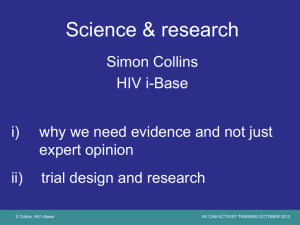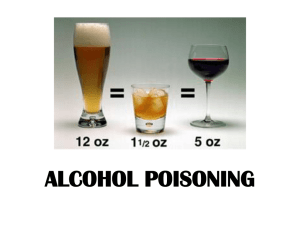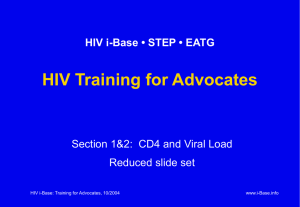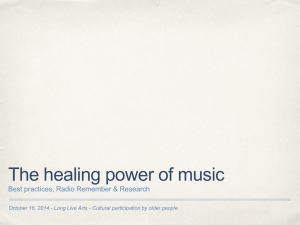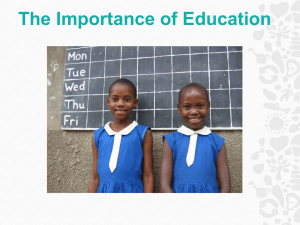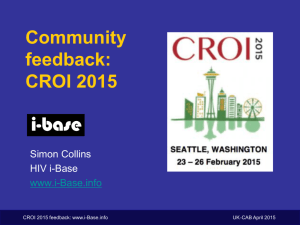Powerpoint slides - HIV i-Base
advertisement
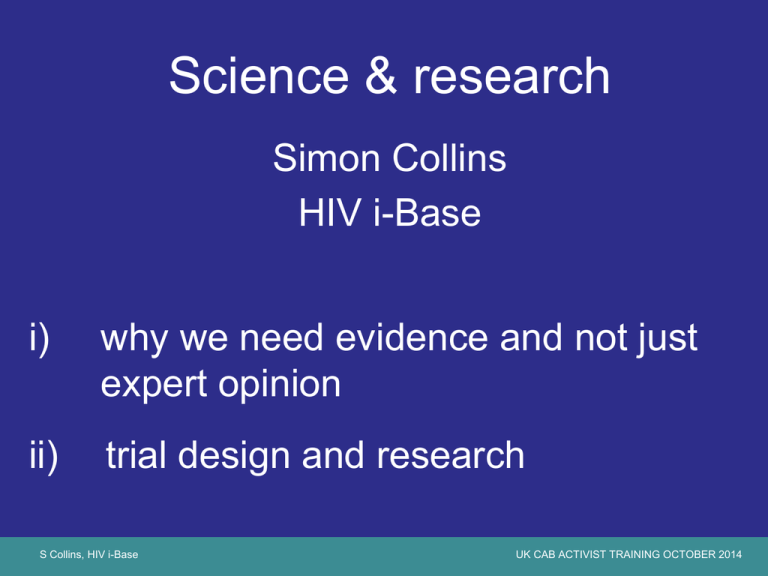
Science & research Simon Collins HIV i-Base i) why we need evidence and not just expert opinion ii) trial design and research S Collins, HIV i-Base UK CAB ACTIVIST TRAINING OCTOBER 2014 Activist training • The CAB is a treatment activist network. Our focus is on science and research because healthcare in the UK is based on “evidence-based medicine” • Understanding the basics of research is essential if we are to explain this to others • This is the start of a learning experience that can develop over many years S Collins, HIV i-Base UK CAB ACTIVIST TRAINING OCTOBER 2014 Activism vs advocacy • Some CAB members identify primarily as either activists or advocates • Activism is an approach where you decide that things could be better than they are. And then doing something to make things change. Lots of people are activists with giving themselves this title. • Advocacy is specific to helping another individual to get better care. S Collins, HIV i-Base UK CAB ACTIVIST TRAINING OCTOBER 2014 Activist training: skills and practice What we learn Our experience S Collins, HIV i-Base thinking reading talking listening writing Communicating and teaching UK CAB ACTIVIST TRAINING OCTOBER 2014 Introduction • • • • • • Please write notes Keep a glossary of new terms and words The training will include new tools to understand and explain research Please report at least one session each for the report Please ask questions Please provide feedback S Collins, HIV i-Base UK CAB ACTIVIST TRAINING OCTOBER 2014 Results are repeatable and generalisable Research study Population results n = 500 n = 500,000 Research needs to be designed so that there is confidence in the results to use them on a population level… Key: n = number S Collins, HIV i-Base UK CAB ACTIVIST TRAINING OCTOBER 2014 Clinical evidence • • • • Studies can prove a theory, disprove a theory or need further studies to answer the question By definition a study can be repeated something is true Research involves extending results from a small to a large group of people Relatively recent – mainstream since 1950 S Collins, HIV i-Base UK CAB ACTIVIST TRAINING OCTOBER 2014 Types of research.1 Different types of study have advantages and disadvantages depending on the study question. 1) Prospective or retrospective: Looking forward or backwards? 2) Observational or experimental: Just observing or experimenting? 3) Cross-sectional or longitudinal: Single timepoint or following over time? S Collins, HIV i-Base UK CAB ACTIVIST TRAINING OCTOBER 2014 Types of research.2 Different types of study also provide different levels of evidence: • Randomised, controlled trial (RCT) - doubleblinded, clinical vs surrogate endpoints • Cohort studies • Cross-sectional study • Case-control study • Systematic literature review / meta-analyses • Case report / case review • Expert opinion S Collins, HIV i-Base UK CAB ACTIVIST TRAINING OCTOBER 2014 Clinical research • • • Every study starts with an idea – sometimes called a theory or question or hypothesis Write down three study questions Different types of studies produce different types of results Write down three types of studies Every study tells a story – we need to understand the story first before we can explain it to anyone else List three recent health studies S Collins, HIV i-Base UK CAB ACTIVIST TRAINING OCTOBER 2014 Study format • Title – summary of research (impartial, not showing results?) • Background – why the study is important • Methods – outline of what will be done • Results – outcome – what was observed • Discussion – implications, strengths and weaknesses of the study • Conclusion – summary of what was proven or not. Read everything by asking questions S Collins, HIV i-Base UK CAB ACTIVIST TRAINING OCTOBER 2014 Randomised clinical trial - RCT * http://en.wikipedia.org/wiki/Randomized_controlled_trial S Collins, HIV i-Base UK CAB ACTIVIST TRAINING OCTOBER 2014 Clinical evidence – examples • Citrus fruit and scurvy * • Streptomycin for TB * • START – Using ART when CD4 is >500 vs 350 cells/mm3 • PARTNER – what is the risk of transmission when viral load is <50 c/mL * http://en.wikipedia.org/wiki/Randomized_controlled_trial S Collins, HIV i-Base UK CAB ACTIVIST TRAINING OCTOBER 2014 James Lind - Scurvy Background: Sailors health at sea Methods: N=12 scorbutic sailors into six groups of two. •They all received the same diet, plus: Group 1 - a quart of cider daily, Group 2 - twenty-five drops of elixir of vitriol (sulfuric acid), Group 3 - six spoon of vinegar, Group 4 – 0.5 pints of seawater, Group 5 - two oranges and one lemon Group 6 - a spicy paste plus a drink of barley water. Results •The treatment of group five stopped after six days when they ran out of fruit, but by that time one sailor was fit for duty while the other had almost recovered. Apart from that, only group one also showed some effect of its treatment. Conclusion - ?? •http://en.wikipedia.org/wiki/James_Lind S Collins, HIV i-Base UK CAB ACTIVIST TRAINING OCTOBER 2014 Streptomycin – BMJ 1948 Background: TB – no available treatment Methods: N=107 - randomised to streptomcin (n=55) - 0.5 mg IM, every 6 hours for 4 months vs control (n=52). Not aware of study. Results: 7% (n=4) vs 27% (n= 14) deaths within 6 months – statistically significant – less than 1% likelihood it could happen by chance; and 51% (n=28) vs 8% (n=4) improved (<0.001% by chance); esp in most sick. Conclusion - ?? •http://www.ncbi.nlm.nih.gov/pmc/articles/PMC2091872/ S Collins, HIV i-Base UK CAB ACTIVIST TRAINING OCTOBER 2014 Research example (Streptomycin – BMJ 1948) Background: What was the study question? Methods: • What type of experiment was designed to answer the question? • How? With what? Measuring what? Results: • Who were studied – what type of people? • What was observed? – were there differences between people? • Were results significant? Discussion • What else was important? Were there risks? What other studies are needed? What can we interpret? Conclusion •Was the question answered? How can the results be used? S Collins, HIV i-Base UK CAB ACTIVIST TRAINING OCTOBER 2014 Evidence vs opinion • • • • Evidence-based medicine was only recently formalised - since 1988 Balance of the risks vs benefits of any intervention based on available evidence Categorise evidence based on the quality of the study Formalised in guidelines – often one category for the quality of the study and another for the strength of the recommendation S Collins, HIV i-Base UK CAB ACTIVIST TRAINING OCTOBER 2014 START study • Balance of the risks vs benefits of starting treatment at CD4 >500 vs 350 cells/mm3 • Flow chart – study design • What are the primary and secondary objectives? • Any surprises? S Collins, HIV i-Base UK CAB ACTIVIST TRAINING OCTOBER 2014 PARTNER study • Quantify the risk of HIV transmission when HIV positive partner in on treatment • Flow chart – study design • What are the primary and secondary objectives? • Any surprises? . S Collins, HIV i-Base UK CAB ACTIVIST TRAINING OCTOBER 2014 START Study http://insight.ccbr.umn.edu/ VERY EXCITING – >4000 people with CD4 counts above 500 randomised to early vs late PARTNER Study http://www.partnerstudy.eu/ VERY EXCITING – follows pos/neg couples for HIV transmissions when VL is undetectable S Collins, HIV i-Base UK CAB ACTIVIST TRAINING OCTOBER 2014 Thanks simon.collins@i-base.org.uk www.i-base.info www.ukcab.net S Collins, HIV i-Base UK CAB ACTIVIST TRAINING OCTOBER 2014 TasP: available evidence Rodger et al. Antiviral Therapy 2013; 18:285–287 S Collins, HIV i-Base UK CAB ACTIVIST TRAINING OCTOBER 2014 TasP: available evidence Study (n = couples) No of transmissions Rate per 100 PYFU (95%CI) % couples no condoms F/U time with risk (years) HPTN-052 (n=1763) 1 0.1 (0.0, 0.4) 7 63.4 Metaanalysis (n=93+393) 0 0 (0, 1.27) 25 218.25 Partners (n=3381) 1 0.37 (0.09, 2.04) 7 19.1 Rakai (n=32) 0 0 (0, 5.98) 46 28.9 Adapted from Rodger et al. Antiviral Therapy 2013; 18:285–287 S Collins, HIV i-Base UK CAB ACTIVIST TRAINING OCTOBER 2014
